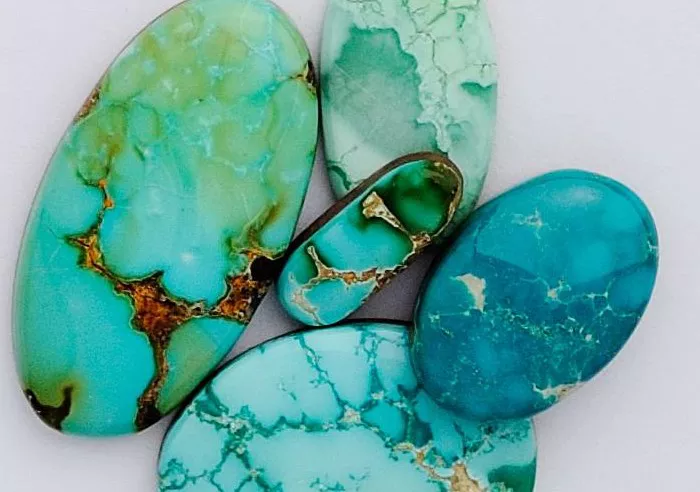Turquoise is a captivating color that blends blue and green. It is named after the gemstone turquoise, which has been cherished for centuries. This unique hue carries deep meanings across cultures, art, fashion, and psychology. In this article, we will explore the symbolism of turquoise. We will look at its historical significance, cultural meanings, psychological effects, and modern interpretations.
The Origin of Turquoise Color
Turquoise gets its name from the gemstone. The word “turquoise” comes from the French pierre turquoise, meaning “Turkish stone.” This is because the stone was first brought to Europe through Turkey. The color itself is a mix of blue and green, often resembling the clear waters of tropical seas.
The exact shade of turquoise can vary. Some turquoise colors lean more toward blue, while others have a stronger green tone. This variation affects its symbolism in different contexts.
Historical Symbolism of Turquoise
Turquoise has been valued since ancient times. Many civilizations associated it with power, protection, and spirituality.
Ancient Egypt
The Egyptians loved turquoise. They used it in jewelry, amulets, and burial masks. They believed it had protective powers. The goddess Hathor, associated with joy and motherhood, was often called the “Lady of Turquoise.”
Native American Cultures
Native American tribes, especially the Navajo, Hopi, and Zuni, considered turquoise sacred. They believed it connected the earth and sky. Warriors wore turquoise for protection in battle. Shamans used it in healing rituals. It also symbolized wealth and status.
Persian and Middle Eastern Traditions
In Persia (modern-day Iran), turquoise was a symbol of heaven. It was used to decorate palaces, mosques, and jewelry. Many believed it could protect against evil and bring good luck.
Ancient Tibet and China
Tibetan Buddhists used turquoise in spiritual rituals. They saw it as a stone of wisdom and compassion. In China, turquoise was linked to immortality and was often placed in tombs.
Cultural Meanings of Turquoise
Different cultures attach different meanings to turquoise. Here are some key interpretations:
Protection and Healing
Many cultures believe turquoise wards off negative energy. It is thought to protect against accidents, illness, and evil spirits. Some people wear turquoise jewelry for its supposed healing properties.
Wisdom and Communication
Turquoise is linked to clear thinking and honest communication. In some traditions, it helps people speak their truth. It is also associated with wisdom and spiritual insight.
Balance and Calm
Because turquoise combines blue (calm) and green (growth), it symbolizes balance. It is said to bring emotional stability and inner peace.
Friendship and Love
Turquoise is sometimes called the “friendship stone.” It represents loyalty, trust, and strong relationships. In some cultures, giving turquoise jewelry is a sign of deep affection.
Psychological Effects of Turquoise
Colors influence our emotions and behavior. Turquoise has several psychological effects:
Calming and Refreshing
Turquoise has a soothing effect, similar to blue. It can reduce stress and promote relaxation. Many people find it refreshing, like the ocean or a clear sky.
Creativity and Clarity
Turquoise is believed to stimulate creativity. It helps with clear thinking and problem-solving. Artists and writers sometimes use turquoise in their workspaces for inspiration.
Confidence and Self-Expression
Because turquoise is linked to communication, it can boost confidence. Wearing turquoise might help people express themselves more openly.
Turquoise in Fashion and Design
Turquoise is a popular color in fashion, interior design, and branding.
Fashion
Turquoise clothing and accessories stand out. They evoke a sense of freshness and energy. Turquoise jewelry, especially rings and necklaces, is timeless. It pairs well with neutral colors like white, beige, and brown.
Interior Design
Turquoise is used in home décor to create a relaxing atmosphere. It works well in bathrooms, bedrooms, and living spaces. Light turquoise makes rooms feel airy, while darker shades add depth.
Branding and Marketing
Many brands use turquoise to convey trust, creativity, and tranquility. Companies in wellness, travel, and beauty often choose this color. Examples include Tiffany & Co., which uses a signature turquoise blue in its branding.
Turquoise in Modern Symbolism
Today, turquoise continues to hold meaning in different areas:
Spirituality and New Age Beliefs
In modern spirituality, turquoise is seen as a stone of protection and healing. It is used in meditation and energy work. Some believe it helps with emotional balance and self-discovery.
Environmental Awareness
Turquoise is associated with nature—water, sky, and earth. Environmental movements sometimes use turquoise to symbolize clean oceans and sustainability.
Personal Style and Individuality
People who love turquoise often appreciate its uniqueness. Wearing turquoise can be a way to express individuality and free-spiritedness.
Conclusion
Turquoise is more than just a color. It carries deep historical, cultural, and psychological meanings. From ancient protection charms to modern fashion statements, turquoise remains powerful. It symbolizes wisdom, calm, friendship, and creativity. Whether in jewelry, art, or design, turquoise continues to inspire and uplift.
Understanding its symbolism helps us appreciate its beauty even more. Next time you see turquoise, think about its rich history and the emotions it evokes. Do you wear turquoise for its meaning, or simply because you love its vibrant hue? Either way, this captivating color will always hold a special place in human culture.
Related topics:
Amethyst vs. Turquoise: Which Gemstone for Your Ring?
Handcrafted Eagle Turquoise Ring: Wear a Piece of Nature’s Art


